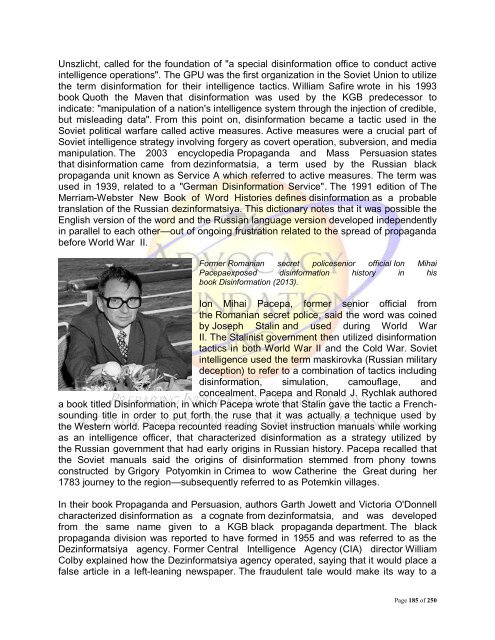Institutional Racism
Institutional Racism
Institutional Racism
You also want an ePaper? Increase the reach of your titles
YUMPU automatically turns print PDFs into web optimized ePapers that Google loves.
Unszlicht, called for the foundation of "a special disinformation office to conduct active<br />
intelligence operations". The GPU was the first organization in the Soviet Union to utilize<br />
the term disinformation for their intelligence tactics. William Safire wrote in his 1993<br />
book Quoth the Maven that disinformation was used by the KGB predecessor to<br />
indicate: "manipulation of a nation's intelligence system through the injection of credible,<br />
but misleading data". From this point on, disinformation became a tactic used in the<br />
Soviet political warfare called active measures. Active measures were a crucial part of<br />
Soviet intelligence strategy involving forgery as covert operation, subversion, and media<br />
manipulation. The 2003 encyclopedia Propaganda and Mass Persuasion states<br />
that disinformation came from dezinformatsia, a term used by the Russian black<br />
propaganda unit known as Service A which referred to active measures. The term was<br />
used in 1939, related to a "German Disinformation Service". The 1991 edition of The<br />
Merriam-Webster New Book of Word Histories defines disinformation as a probable<br />
translation of the Russian dezinformatsiya. This dictionary notes that it was possible the<br />
English version of the word and the Russian language version developed independently<br />
in parallel to each other—out of ongoing frustration related to the spread of propaganda<br />
before World War II.<br />
Former Romanian secret policesenior official Ion Mihai<br />
Pacepaexposed disinformation history in his<br />
book Disinformation (2013).<br />
Ion Mihai Pacepa, former senior official from<br />
the Romanian secret police, said the word was coined<br />
by Joseph Stalin and used during World War<br />
II. The Stalinist government then utilized disinformation<br />
tactics in both World War II and the Cold War. Soviet<br />
intelligence used the term maskirovka (Russian military<br />
deception) to refer to a combination of tactics including<br />
disinformation, simulation, camouflage, and<br />
concealment. Pacepa and Ronald J. Rychlak authored<br />
a book titled Disinformation, in which Pacepa wrote that Stalin gave the tactic a Frenchsounding<br />
title in order to put forth the ruse that it was actually a technique used by<br />
the Western world. Pacepa recounted reading Soviet instruction manuals while working<br />
as an intelligence officer, that characterized disinformation as a strategy utilized by<br />
the Russian government that had early origins in Russian history. Pacepa recalled that<br />
the Soviet manuals said the origins of disinformation stemmed from phony towns<br />
constructed by Grigory Potyomkin in Crimea to wow Catherine the Great during her<br />
1783 journey to the region—subsequently referred to as Potemkin villages.<br />
In their book Propaganda and Persuasion, authors Garth Jowett and Victoria O'Donnell<br />
characterized disinformation as a cognate from dezinformatsia, and was developed<br />
from the same name given to a KGB black propaganda department. The black<br />
propaganda division was reported to have formed in 1955 and was referred to as the<br />
Dezinformatsiya agency. Former Central Intelligence Agency (CIA) director William<br />
Colby explained how the Dezinformatsiya agency operated, saying that it would place a<br />
false article in a left-leaning newspaper. The fraudulent tale would make its way to a<br />
Page 185 of 250

















